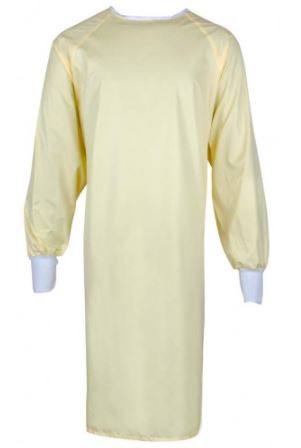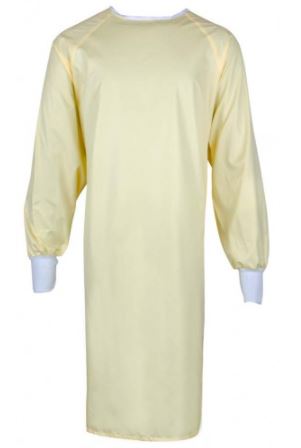ISOLATION GOWN, microfiber, standard perf., reusable
Valid Article
ISOLATION GOWN, microfiber, standard perf., reusable
Definition
A garment made of natural and/or synthetic materials intended to be worn by healthcare providers to isolate themselves from patients. The isolation gown helps to protect the patient from the transfer of infectious agents carried by the healthcare provider or visitor; or it may help to protect the healthcare provider or visitor from a contagious agent which has infected the patient.
This is a reusable garment intended to be laundered after each use.
Synonym
surgical smock
Specifications
Microfiber is defined as a staple fiber or filaments of linear density approximately 1 dtex or less, and above 0.3 dtex (Decitex = measuring unit for yarn; 1 gram per 10000 meters). Polyester and polyamide are the main source to produce microfibers.
Fabrics made of microfibers are generally lightweight, resist wrinkling, have a luxurious drape on the body, retain shape, and resist pilling. They are also relatively strong and durable in relation to other fabrics of similar weight, and they are more breathable and more comfortable to wear. Fabrics made of microfibers show lower heat conductance and therefore higher thermal insulation properties.
Technical specifications
- Fabric: microfiber carbon fabric, antistatic, water-resistant, high breathability. Latex-free. Withstands boiling and sterilization by steam autoclave; resists to chlorine 0.1%
- Barrier capacity of the whole gown: (liquid and bacterial penetration): standard performance
- non sterile, reusable
- impervious to liquids, flexible
- Wraparound gown, opening in the back with velcro closures or with a waist tie
- neck closure with velcro or with ties
- long sleeves
- at the wrists an elastic or jersey band
- coverage of the whole upper body till under the knees required (110 - 130 cm)
- colour: light
Instructions for use
Maintenance
Adapt procedure according the context and the temperature limits of the manufacturer.
All gowns must be laundered prior to use.
Barrier fabrics should be laundered separate from other hospital linens to minimize lint accumulation from other products and maximize the economics of the lightweight polyester fabric.
Recommended washing formula: Combination washer/extractors should be loaded at approximately 70-75% capacity to allow correct flow of water across surfaces of these fabrics.
- Do not use softener.
- Do not use a brush: as the fabric is water repellent liquids will not penetrate. The use of a brush will deteriorate the fabric faster!
During the washing process a chemical or thermal disinfection is necessary - chemical disinfection can be done by active oxygen releasing chemicals (e.g. peracetic acid) or 0,1% chlorine solution (keep in mind that chlorine could reduce the maximum lifetime of the surgical gowns and drapes)
Take care to have a sufficient rinsing to avoid damaging of the surgical gowns during the following drying and sterilization process as well as to avoid skin reaction due to a to high pH value or residual detergents on the gown.




